Ootz’s recent comment raised the question:
-
should we be seriously looking at what the safe levels of CO2 in the atmosphere are for human beings?
That was in the context of an informed comment that we have not seen CO2 levels above 320 ppm for 27 million years, which predates hominid evolution. Studies indicate that 600 ppm globally, which is where we could be by 2050, might just render us extinct.
To jump to the chase, we don’t really know what the full effects of elevated CO2 will be, or indeed what they are now. However, indications are that as CO2 rises, our brains will work less well and we will become more limp and sluggish. A bit like a frog in a pot of water gradually being heated.
First, let’s look at where we are headed with emissions. This graph comes from October 2015, when the participating countries had put in their intended actions prior to the Paris Agreement:
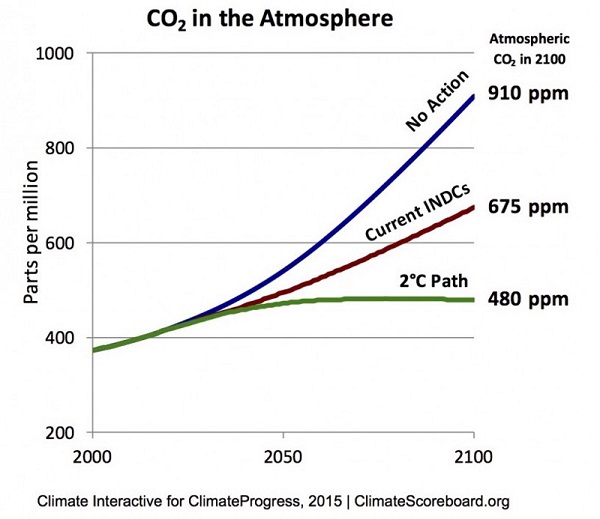
Little has changed since then in terms of intentions. Let’s check how we are doing at Mauna Loa via NOAA. Here’s the five-year graph:

This one takes us back to 1960, when we were at about the 320 mark:
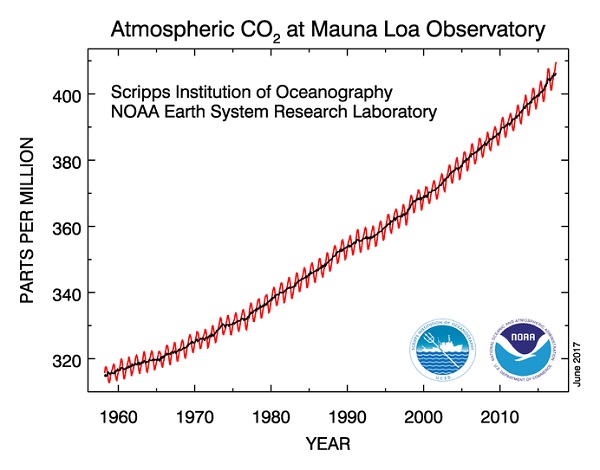
This one shows that the annual growth rate is now about three times what it was in 1960:
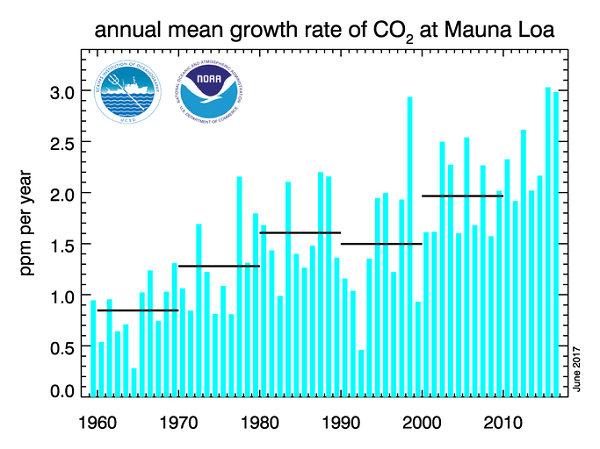
So unless something changes, we are heading for 600 ppm or beyond.
The first link in Ootz’s comment was to an article by D S Robertson in 2006.
He states that the effect of CO2 is to create carbonic acid in the bloodstream, which is an alkaline fluid. He argues CO2 becomes toxic with lifetime exposure at 426 ppm, citing work he did himself in 2001. He says:
- The minimum effects of acidosis are restlessness and mild hypertension. As the degree of acidosis increases, somnolence and confusion follow. One of the effects of these changes is a reduced desire to indulge in physical activity. Other metabolic effects of acidosis have been reviewed and shown to be extensive. Embryonic or foetal abnormalities are also possible as the increase in atmospheric carbon dioxide affects maternal metabolisms in succeeding generations.
Robertson argues that CO2 levels have not been above 320 ppm for 27 million years, when they were three times as high as now. He states that the fossil record shows that primates were abundant at this time on the Eurasian continent, but then disappeared, presumably because of the high CO2.
Just why high CO2 should be restricted to Eurasia while primates continued in Africa, I’m not sure.
He says that occupants of a room start to perceive it as stuffy at 600 ppm, and that crowded conference rooms see CO2 as high as 2000 ppm.
He thought that in 2006 we may have already reached a point where athletic records will no longer be broken.
Well he was definitely wrong about that. How about his other statements?
First up, primates have been around for at least 65 million years. During that time CO2 levels were presumably a lot higher than the are now. During the Paleocene–Eocene Thermal Maximum 55mya CO2 levels increased by 700 ppm, on a base unknown, but possibly 1000ppm or more. During that time mammals actually flourished. However, we are putting CO2 into the atmosphere somewhere between 20 and 120 times as fast. He’s right in saying there will be no evolutionary human adaptation this time.
Another issue is that according to work done by Aradhna Tripati et al temperatures were ~3° to 6°C warmer and sea level was 25 to 40 meters higher than at present during the Middle Miocene around 15 to 17mya. Elsewhere we are told she found CO2 to be 400-450ppm at the time, close to present levels. Apes got going about 17mya, as it happens in Europe rather than Africa.
So I’m encouraged to think we will survive 450 ppm, but there is still concern that Robertson might be right in concluding that populations will experience deteriorating health outcomes at 426 ppm and if we head for 600 – 750 ppm “then the biosphere and humankind are seriously threatened.”
In 2012 Usha Satish et al studied cognitive performance in what they called low to moderate CO2 environments in 2.5 hour bursts, namely at 600 ppm, 1000 ppm and 2500 ppm.
Here’s a summary from Joseph Stromberg at Smithsonian.com (thanks BilB for the link):
- Although the researchers suspected the participants’ abilities might diminish slightly, they were surprised by just how significant the effects of the carbon dioxide were. Decision-making decreased moderately at 1,000 ppm as measured on seven of the nine scales, with decreases ranging from 11 to 23 percent, and significantly on those same scales at 2,500 ppm, with decreases of 44 to 94 percent. The most dramatic effects were found in the participants’ ability to engage in strategic thinking and take initiative. “The magnitude of effects measured at 2,500 ppm was astonishing—so astonishing that it was almost hard to believe,” Berkeley Lab scientist Mark Mendell, a coauthor, told Science News.
This graph illustrates their findings:
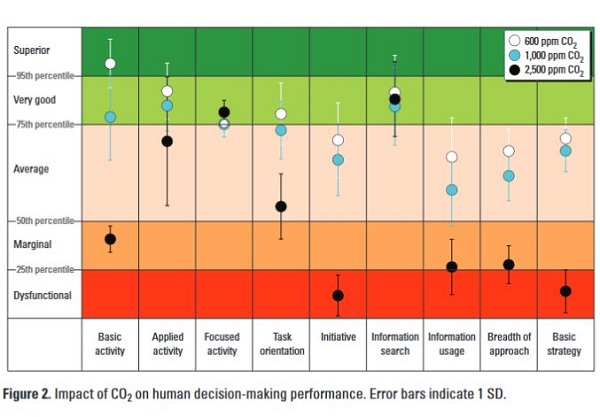
CO2 in meeting and conference rooms sometimes goes above 3000 ppm. Now we can understand the true meaning of ‘hot air’ and why decision-making in government, business and elsewhere is so poor. Everyone breathes out about 4% CO2. The Xerox machine in the 1960s made large committees possible. Before that they were limited to six or seven by the number of carbon copies the secretary could use to produce the minutes with a typewriter. Now we not only have larger meetings, we fill the room with CO2 producing support staff and minders.
Would you believe, building ventilation regulations in the US allow up to 5000 ppm?
I checked the Australian Building Code (can’t link) and it said 5000 ppm, but we should keep levels below 850 ppm averaged over 8 hours, because at that point we start to smell bad!
Ootz’s second link is to a paper by P N Bierwirth in 2014. I’ll post here his table summarising research to date, showing levels of CO2, health effect, the duration of the exposure, and the source of the study. I’ve truncated the table to show only below 5000 ppm in the interests of legibility and because 5000 ppm is the level allowed in the American building code:
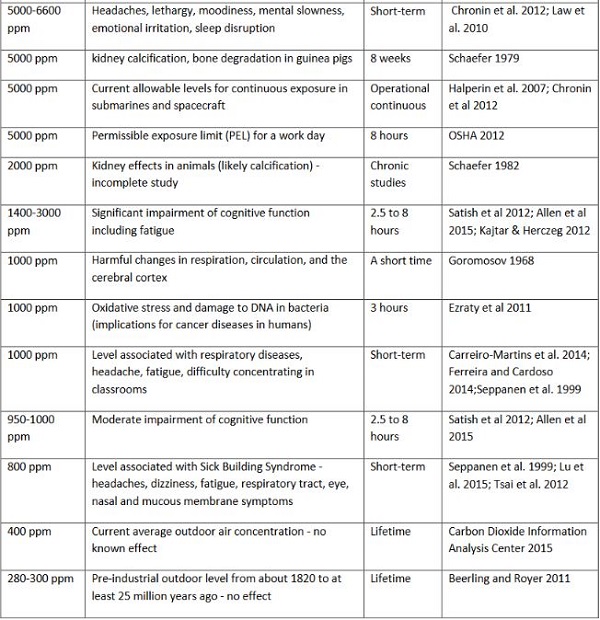
The head of his table suggests serious effects from exposures from 20 days to 6 weeks in concentrations of 7000 to 10,000 ppm.
He says the whole primate evolutionary lineage has only experienced levels below and up to the current level of 400 ppm, which is I think not strictly true, but near enough for the last 27 million years. He adduces a lot of evidence of serious harm from exposure at quite low levels, and bemoans the fact that little attention is being given to the matter by policy makers or the IPCC.
He says that most of the problems associated with elevated indoor CO2 levels greater than about 800 ppm can be alleviated by spending time in fresh air, but:
- While this sounds alarmist, the fact remains that the level of CO2 in the ambient atmosphere, beyond which the health or survival of the species could be threatened, remains unknown.
This is the main paragraph of his conclusions:
- Current impacts of elevated and increasing ambient CO2 in indoor environments include respiratory diseases, headaches, fatigue and other symptoms at levels above 800 ppm. This finding together with the impairment of cognitive abilities at CO2 levels just above ambient (between 600 and 1,000 ppm) is significant in that it has implications at a societal level for human function particularly for jobs with critical responsibility ( e.g. surgery, air-traffic controllers, drivers etc.) together with the impact on learning, human development and economies. These impairing CO2 effects will be increased and more permanent in a future with elevated outdoor ambient CO2 concentrations. Other ongoing impacts may include the exacerbation by CO2 of cellular oxidative stress resulting in an increase in cancers, neurological diseases, viruses and many other conditions. Studies of health effects at higher levels of CO2 at around 2,000-5,000 ppm demonstrate the impact of persistent attempts by the body to compensate for increased acidity in the blood. These effects include kidney calcification, bone degradation and cerebral blood flow disorders. The latter can be related to a decrease in cognitive abilities and potential brain damage. While there is a lack of studies in humans at lower CO2 levels, demonstrated effects in animals and symptoms experienced by humans indicate that longer-term mechanisms compensating for increased blood CO2 might be active when breathing at around 800-1000 ppm CO2. This is a level predicted for the ambient atmosphere by the end of the century in a “business as usual” world. This means that most humans could at this time be experiencing persistent body compensation for acidosis effects resulting in serious health problems. The risk for human and animal population health in the near-future is extremely high and should be communicated since global awareness of this issue may enable a change in CO2 emission activities.
Bierwirth has reviewed a lot of literature in coming to these conclusions. To barrel on past 600 ppm would be plain stupid.
Stupid is what we become when we try to work in what are now considered ‘normal’ levels of CO2.
Satish et al only had a sample size of 22. In 2015 the Harvard School of Public Health conducted an experiment looking at cognitive performance in ‘Green’ and ‘Conventional’ buildings (Satish was a joint author). From their paper:
- Methods: Twenty-four participants spent 6 full work days (0900–1700 hours) in an environmentally controlled office space, blinded to test conditions. On different days, they were exposed to IEQ conditions representative of Conventional [high concentrations of volatile organic compounds (VOCs)] and Green (low concentrations of VOCs) office buildings in the United States. Additional conditions simulated a Green building with a high outdoor air ventilation rate (labeled Green+) and artificially elevated carbon dioxide (CO2) levels independent of ventilation.
- Results: On average, cognitive scores were 61% higher on the Green building day and 101% higher on the two Green+ building days than on the Conventional building day (p < 0.0001). VOCs and CO2 were independently associated with cognitive scores.
- Conclusions: Cognitive function scores were significantly better under Green+ building conditions than in the Conventional building conditions for all nine functional domains. These findings have wide-ranging implications because this study was designed to reflect conditions that are commonly encountered every day in many indoor environments.
Many people are now spending around 90% of their time inside.
When the Harvard study isolated CO2 they found:
- For seven of the nine cognitive function domains, average cognitive scores decreased at each higher level of CO2 (Table 5). Cognitive function scores were 15% lower for the moderate CO2 day (~ 945 ppm) and 50% lower on the day with CO2 concentrations of ~1,400 ppm than on the two Green+ days (Table 5, dividing the average Green+ estimate by the moderate CO2 and high CO2 estimates, respectively).
This graph is instructive:
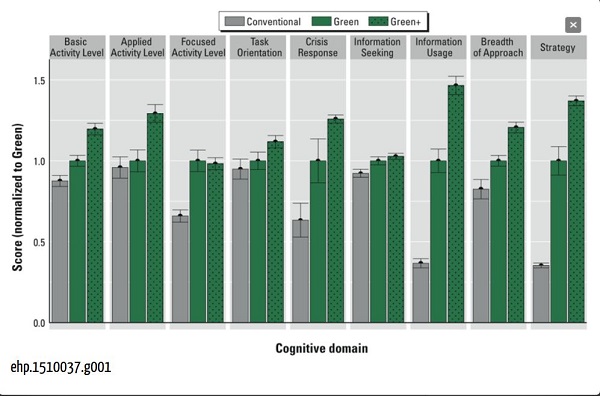
“Conventional” was 945 ppm and “Green +” was 500 ppm.
They say:
- On average, a 400-ppm increase in CO2 was associated with a 21% decrease in a typical participant’s cognitive scores across all domains.
There is a lot of fine detail in the study. They note that their results are similar to those obtains by Satish et al and a 2015 study by Maddalena et al.
This statement is worrying:
- Assessment of public housing units in Boston found median CO2 levels to be 809 ppm in conventional apartments and 1,204 ppm in the newly constructed LEED® platinum apartments (Colton et al. 2014). Corsi et al. (2002) reported CO2 concentrations > 1,000 ppm in 66% of 120 classrooms in Texas, and Shendell et al. (2004) measured CO2 concentrations > 1,000 ppm in 45% of 435 classrooms in Washington and Idaho and reported that elevated CO2 concentrations were associated with increases in student absences.
Joe Romm posts on the Harvard study and comes up with a number of important points.
Firstly, researchers in this area work within the public health silo, not the climate silo.
Secondly, the ambient levels of CO2 in cities can be up to 100 ppm higher than elsewhere.
Third, there has been extensive research that shows environmental dissatisfaction cuts in for workers at about 600 ppm.
Romm points out that the Harvard study found that the detrimental effect of CO2 was linear, but we really have no idea where it starts.
Romm did a lot of research on the topic for his book, and the overall message is we need more research, but we are right to be alarmed. Building ventilation standards need immediate attention, but in terms of climate and public health, as a precautionary, risk management matter we should slam on the brakes hard as soon as possible. The notion that we can overshoot and then draw down with impunity is risky to say the least.
My sense is that it’s probably alarmist to think we’ll all die if we reach 600 ppm, but remember that this means large populations will be living without respite in levels significantly above 600. The frog in a warming pot analogy is uncomfortably close to the bone.
Before I finish, it would be remiss not to mention the disaster of Lake Nyos in 1986, where a sudden upwelling of CO2 killed 1,746 people and 3,500 livestock within 25 kilometres of the lake. However, this tells us nothing about CO2 toxicity. If you have no air you suffocate.

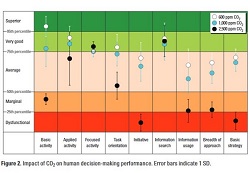
Thanks, Brian (and Ootz) , very comprehensive and informative.
No problems, thanks, BilB.
I wonder whether there is anything more up to date, but my Googling did not uncover anything.
I guess my reaction is that this dimension of global warming and climate change makes it all the more urgent that we adopt James Hansen’s call to get the atmosphere back to 350 ppm ASAP, and by that time we should have worked out what needs to be done next.
Instead we now have a significant rump of our ruling party, including the deputy PM, openly calling for the continuation of coal. Indeed they want new coal, although it’s not the cheapest way to go.
The reality of the CO2 level is that it will severely affect us indirectly in the damage caused to the oceans and the climate well before it addles our brains.
Having said that, it is important to note that as the background CO2 level rises it narrows the operational band for our activities, ie shorter time in crowded rooms before CO2 rises to dangerous levels, increased rate of ventilation required in future and that should be planned for now for buildings with a 50 year commercial life.
Maybe some people are more sensitive to high CO2 levels than others. Somehow Malcolm Roberts, Tony Abbott and Barnaby crossed my mind.
BilB, current levels of CO2 could get us 25 to 40 metres of sea level rise, given a millennium or two. However, 600 ppm and a metre of SLR could arrive about the same time, in about 30-50 years.
That would be panic stations.
What the weather will be like, and whether we would have tripped other tipping points are known unknowns.
Hyperventilation is dangerous when skin diving because it is the CO2 level that tells the body that it is time to take another breath, not the shortage of oxygen. (Hyperventilation removes CO2 from the body and delays the “time to go up signal.)
We may find that the effect of higher CO2 levels in the air we breath will be a distraction until our body adjusts.